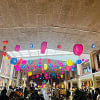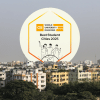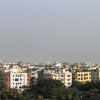How can we bring our canals back from the dead?

Imagine a formidable rainfall of 134 millimetres flooding the whole city within a day – bringing commuters to a halt for hours, and tragically putting to death a whole family in Mirpur – while dengue raises fatalities precipitously in just a few months. This description might resonate with a cataclysmic movie scene, but alas! These are merely hard news from the ever-bustling mega city Dhaka.
A study published in 2011 stated that Dhaka witnessed the desiccation of about 60 percent of its existing wetlands and 65 percent of rivers and canals in the last three decades. Many argue that rapid, unplanned urbanisation is the major culprit behind the loss of water bodies, resulting in acute waterlogging. Meanwhile, as polluted canals remain exposed, they breed mosquitoes resulting in recurrent dengue outbreaks, the most widespread one occurring this year, killing over 1,200. Clearly, terrains that once birthed and nourished the city have now mutated into sullied, ominous urban risks.
The canals of Dhaka are vanishing; they are victims of a lack of systematic development, but there is still a chance to recompense. A strategically devised plan for the city will help to sustain the cleanliness of the canals. By improving the urban fabric around and along the water bodies, the community's relationship can be rebuilt with the waters through diverse activities. In his book Designing Dhaka: A Manifesto for a Better City (2012), architect Kazi Khaleed Ashraf urges planners to think beyond "land-use" planning, introducing a new term – "land-water use" planning. Dhaka's morphology will only harmonise with urbanisation when its water bodies are paid due attention in planning schemes, a mantra that can placate the flooding canals, and bridge the gap between urban and riverine Dhaka.
For years, Dhaka dwellers harboured the insolence to devour all water bodies of the city. The waters, having no alternative, drowned us to avenge the injustice that we inflicted upon it through our carelessness and greed. We must immediately reinstate the symbiotic relation with the waters, engendering a sense of responsibility and ownership within the community.
Dhaka should be re-evaluated under a new planning scheme that promotes a river or canal-based transit oriented development (TOD). The canals have the potential to facilitate regional water transportation networks or become community transit channels. But why should TOD be implemented?
For the city, boating services can prove to be much faster for local commuters, as witnessed at Hatirjheel lake. The Dhaka Structure Plan, 2016-2035 proposes the TOD model – incorporating metro rail, bus stations, auto-rickshaws, and rickshaw stations for transportation facilities. If we obligate the inclusion of boat stations as a part of the TOD, waterway excavation projects will be conducted regularly, and this will in turn ensure the active use and revival of our waterways. All these positive outputs come in a package. In this endeavour, a community-level intervention is necessary to revive our locales' relationship with water.
From a detailed site appraisal of the Kallyanpur canal, which I have carried out as part of a university study, it was deduced that two major nodes have spontaneously formed in the neighbourhood. There is a central transit area at Kallyanpur bus stand, containing crowds from all over the city (75-100 passengers change transport mode per minute), and a smaller scale of transit occurs within the neighbourhood, where pedestrians exchange modes of transport for non-motorised vehicles (10-15 passengers per minute). Therefore, besides a central TOD that incorporates the canal, community transit nodes should also be proposed at regular walkable intervals to facilitate neighbourhood commuting using the water body. Such nodes would resemble the characteristics of a public square that accommodates transit facilities for vehicles such as small boats, rickshaws, autorickshaws, and bicycles.
Since the central transit station will connect multiple regions of Dhaka, commuters should be attracted with a riveting visual and physical experience highlighting the canal. The station's design must provide direction to crowds to the boat service edge, on-street vehicle stands and the pedestrian edge along the canal. The station can be a low-height, green-roofed, vibrant pavilion where temporariness of commercial activities is given priority, with restaurants and recreational activities providing a rejuvenating interlude to commuters, like the ones in Bangkok or Istanbul.
The canal's edge should be a safe, interactive space for pedestrians. To begin with, the internal neighbourhood streets that vehicles use should be reconnected, and then linked to the edge through landscaping, allowing at least a 15-m buffer zone between the canal and built structures. Pedestrianism must be facilitated by commercialising the ground floors by the edge, and infill spaces should be designed to accommodate the needs of an inclusive society, introducing activities like community gardening, playgrounds, and shops. Besides implementing a holistic planning scheme for the city's canals, it is imperative for the communities to utilise the socio-economic resources that these water bodies can offer.
For years, Dhaka dwellers harboured the insolence to devour all water bodies of the city. The waters, having no alternative, drowned us to avenge the injustice that we inflicted upon it through our carelessness and greed. We must immediately reinstate the symbiotic relation with the waters, engendering a sense of responsibility and ownership within the community. As architect Khaleed Ashraf asserts, when waterfronts are reorganised as recreational, civic, economic, and transport hubs, they turn into the "sustainable lifeblood" for a city. So, can we not work strategically, citizens and implementers hand-in-hand, to let the blood flow free through Dhaka's veins?
Oindriza Reza Nodi is an architect currently working as a junior research and design associate at Bengal Institute of Architecture, Landscapes and Settlements.

 For all latest news, follow The Daily Star's Google News channel.
For all latest news, follow The Daily Star's Google News channel. 











Comments